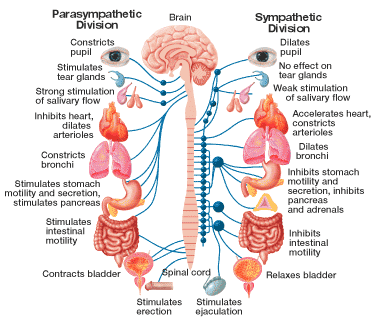
 |
Nervous SystemChimpanzees and mammals have the most complex nervous system on the planet besides humans. With the senses the nervous system works to transmit information to the brain which takes less than one-hundredth of a second. Their brains are programmed to react to the world quickly in order to protect themselves from danger and to allow it to analyze the environment easily. TypeThe nervous system of a mammal, such as the Chimpanzee, is revolved on the brain and the spinal cord which sends and retrieves signals from the rest of the body. These signals that come from the body are sent through nerve endings, also known as receptors, to the brain where neurotransmitters send a signal to let all mammals feel pain or other sensory information. The nervous system is divided into four main sections: the central nervous system, the peripheral nervous system, the somatic nervous system, and the autonomic nervous system. Each one of these parts of the nervous system works in a different way and perform different roles in the body to keep healthy and allow you to react to the world properly. Peripheral Nervous SystemThe peripheral nervous system is made of only connecting nerves. The nerves work to connect the spinal cord, where the sensory information is retrieved to the brain where the information is processed. The two main sections of the peripheral nervous system are the somatic and the automatic nervous systems. Somatic Nervous SystemThe somatic nervous system controls both the muscles and the information that is processed by the skin and other receptors. Very often, you don't need to process the information consciously, since your body uses reflexes to respond to external stimuli that is being sent to your peripheral nervous system. Autonomic Nervous SystemThe autonomic nervous system is separated into two parts. The sympathetic nervous system and the parasympathetic nervous systems work together to keep homeostasis in a mammal during stressful times. The sympathy in the nervous system is responsible for starting the flight or fight response which prepares the body to be able to deal with dangerous situations. BenefitsIn the nervous system the basic parts are the sensory receptors, the brain and the spinal cord. All mammals have nerve endings that are spread over the body so that they can receive and send signals to external stimuli. The sensory organs like the skin and eyes, help a mammal translate what is happening in the external environment and in case of a dangerous situation, it has reflexes to help the mammal avoid harm. The nervous system is also responsible for maintaining homeostasis, or a functioning and stable state for all the organs in the body. All mammals use part of their central nervous system to maintain their heartbeat, breathing, and other bodily functions. The medulla oblongata is the part of the brain that regulates most of these types of activities, including reflex actions like sneezing. The nervous system works to help mammals avoid dangerous situations by letting you feel pain, and hear and see dangerous situations in the environment. When a mammal experiences spinal cord damage, the path that is between the brain and the rest of the body is blocked or interrupted. This can cause paralysis or even death to the mammal because it is so vital to the functioning of the body. |